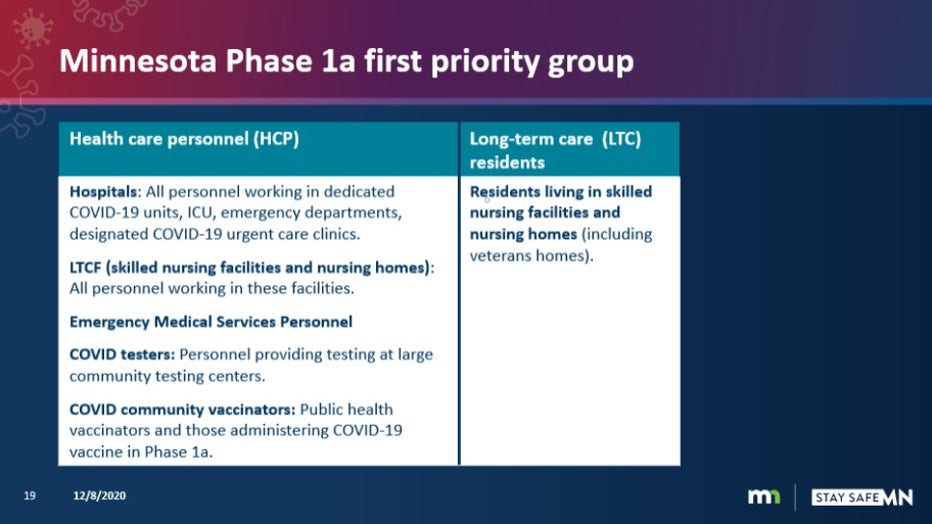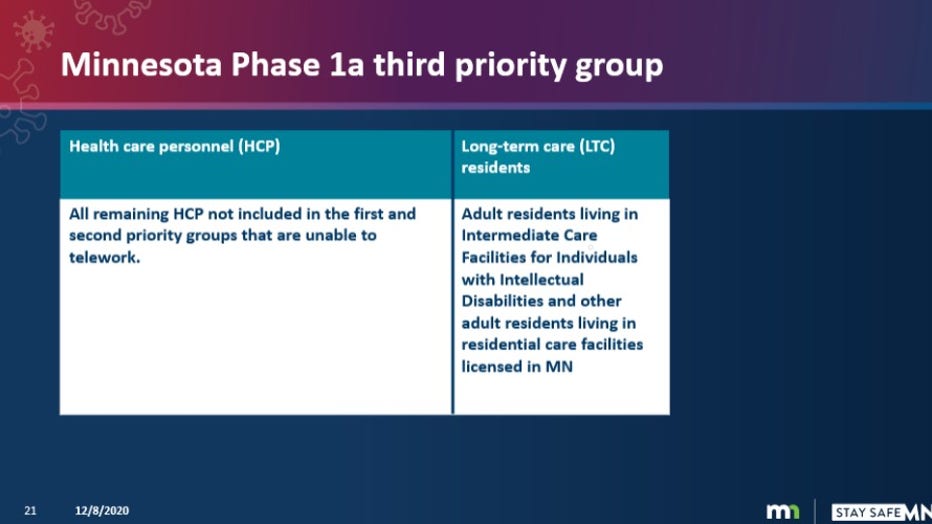Walz: Minnesota in line to get 183,400 COVID-19 vaccines by the end of 2020

Minnesota leaders share COVID-19 vaccine timeline
Minnesota leaders explained the COVID-19 vaccine rollout plan for the state.
ST. PAUL, Minn. (FOX 9) - Minnesota will get enough doses of the coronavirus vaccine to inoculate 183,400 people by the end of 2020, Gov. Tim Walz and state health officials estimated Tuesday.
Health officials said the first shots would go in people's arms about one week after the U.S. Food and Drug Administration authorizes the vaccines for emergency use. The FDA is expected to sign off on Pfizer's vaccine late this week and Moderna's vaccine next week.

Who will get the coronavirus vaccine first in Minnesota
State infectious disease expert Kris Ehresmann breaks down which groups will receive the vaccine first and how it will be distributed.
Minnesota officials cautioned that the first doses will only be the start of a long process, and said the initial vaccines would not even be enough to cover all of the top-priority health care workers and long-term care residents.
"There’s a lot of work to be done. This is going to take time and patience," Walz said during a statewide televised speech. "Minnesota's plan is solid.

Minnesota officials disclose vaccine distribution plan
Everything you need to know about the state of Minnesota vaccine distribution plan.
Minnesota is in line to receive 46,800 Pfizer vaccines next week, with Moderna's shipments making up the rest of what's expected before the end of the year, Walz said.
The federal government is reserving a second dose for each person, meaning an estimated 183,400 Minnesotans will get their first shot by the end of 2020 and their second dose in early 2021.
The vaccine is administered in two doses with the shots given 21 or 28 days apart, depending on whether a person gets the Pfizer or Moderna vaccine.
"We’re saying that it takes about six weeks between when someone receives their first vaccine and when they might expect to have protection from COVID," said Kris Ehresmann, the state's infectious disease director.
Walz and the four top legislative leaders -- two Republicans and two Democrats -- held a unity news conference to encourage people to trust the vaccines.
When a reporter asked if they would get the vaccine when it's offered to them, everyone but Senate Majority Leader Paul Gazelka raised their hands. Gazelka, R-East Gull Lake, got the virus in November and said he thought he has antibodies.
"I’m not against it, I’m just waiting to see how it turns out," Gazelka told reporters.
The governor’s address comes as health officials in the United Kingdom began rolling out the first doses of the Pfizer-BioNTech COVID-19 vaccine on Tuesday.

CDC tells states to prepare for COVID-19 vaccine distribution
Following a letter from the CDC, the Minnesota Department of Health is preparing for upcoming COVID-19 vaccine distribution.
How will vaccines be distributed?
Vaccines will be shipped directly to providers using what Walz described as a “hub and spoke” model.
The vaccines will be shipped directly to 25 key hospitals, or “hubs”, across the state. The hubs have the ultra-cold storage facilities needed to store the vaccine at the correct temperature. From there, the vaccines will be distributed to 118 smaller clinics, the “spokes.”
Who gets first priority?
The Centers for Disease Control and Prevention is recommending health care workers and long-term care residents get vaccinated against COVID-19 first.
Minnesota health officials have broken down the first phase of the state’s vaccine rollout plan into three broad priority groups:
- Phase 1a: Health care workers, long-term care residents
- Phase 1b: Essential workers
- Phase 1c: High-risk adults, adults 65 or older.
Minnesota has some flexibility to prioritize people within each category, but cannot make major changes from the CDC's guidance, Ehresmann said.
Which health care workers and long-term care residents will be first?
Minnesota has about 500,000 people in the CDC's highest-priority group.
The state says the following people will get first priority for a vaccine this month:
- Hospital or urgent care personnel working with COVID patients
- Long term care workers
- EMS workers
- Workers doing COVID testing
- Workers giving COVID vaccines
- Nursing home residents

The state of Minnesota's first priority group for the COVID-19 vaccine. (Minnesota Department of Health)
The second priority group of Minnesotans who will receive the vaccine includes the following:
- Hospital personnel working directly with patients not included in the first group
- Long-term care facility workers not included in the first group
- Urgent care settings personnel working with patients or handling infectious materials
- Dialysis center personnel working with patients or handling infectious materials
- Assisted living residents

The state of Minnesota's second priority group for the COVID-19 vaccine. (Minnesota Department of Health)
The third priority group of Minnesotans who will receive the vaccine includes the following:
- All remaining healthcare workers.
- Adult residents living in intermediate care facilities for intellectual disabilities or residential care facilities.

The state of Minnesota's third priority group for the COVID-19 vaccine. (Minnesota Department of Health)
Ehresmann said she was unable to say when the full group of health care workers and long-term care residents would be vaccinated, and Minnesota would be ready to move on to essential workers.
"Honestly, it keeps changing, and that’s the reason I’m expressing such reluctance to give numbers," she told reporters. "I want Minnesotans to know we’re telling you what we do know, but there’s a lot we don’t know. Things are changing and we will update you when we get more information."
Will people get proof they've been vaccinated?
Yes. Minnesotans will get a card once they've been vaccinated, and should take a photo in case they lose it, Ehresmann said.

